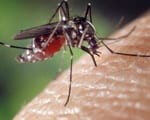Track-and-field rules regarding athletes with prosthetic limbs remain gray, even nonexistent.
The New York Times reporter Filip Bondy interviewed SMU biomechanics expert Peter Weyand of the SMU Locomotor Laboratory, for a story about Hunter Woodhall, an 18-year-old athlete with prosthetic limbs competing against top scholastic stars in the United States.
Weyand, who is Glenn Simmons Professor of Applied Physiology and professor of biomechanics in the Department of Applied Physiology and Wellness in SMU’s Annette Caldwell Simmons School of Education and Human Development, is director of the Locomotor Lab.
An expert on human locomotion and the mechanics of running, Weyand has been widely interviewed about the controversy surrounding double-amputee South African sprinter Oscar Pistorius. Controversy has swirled around the sprinter over whether his light-weight, carbon-fiber prosthetic “Cheetah” legs give him a competitive advantage.
Weyand helped lead a team of scientists who are experts in biomechanics and physiology in conducting experiments on Pistorius and the mechanics of his racing ability.
For his most recently published research, Weyand was part of a team that developed a concise approach to understanding the mechanics of human running. The research has immediate application for running performance, injury prevention, rehab and the individualized design of running shoes, orthotics and prostheses. The work integrates classic physics and human anatomy to link the motion of individual runners to their patterns of force application on the ground — during jogging, sprinting and at all speeds in between.
The New York Times article, “Blade Runner Tests Limits of Prosthetics, Years After Oscar Pistorius,” published March 13, 2017.
EXCERPT:
By Filip Bondy
The New York Times
A decade after Oscar Pistorius caused track-and-field officials to re-examine their rules regarding the use of prosthetic limbs at the Olympics, a high school amputee is running in open competition on similar carbon-fiber blades. And once again, guidelines are gray, even nonexistent.The athlete, Hunter Woodhall, 18, from Syracuse, Utah, is at the Armory track in Manhattan to run in an invitational, 400-meter heat on Saturday at the New Balance Nationals Indoor, competing against the top scholastic stars in the country.
One of the youngest competitors at the Rio Paralympics, Woodhall won silver in the 200-meter competition at 21.12 seconds and bronze in the 400 with a personal-best 46.70. He also appeared to capture gold while anchoring the 4×100 relay, but the United States team was disqualified over an exchange violation on an earlier leg.
Amid these successes, background grumbling appears to have increased in connection with his eligibility for open competitions.
Woodhall has such a winsome personality, it is impossible to imagine anyone complaining to his face about anything. The meet directors are thrilled to have him participate. But there are no hard-and-fast rules regarding the eligibility of bladed runners at scholastic or collegiate levels, and the scientific debate has never been fully settled about whether the prosthetics offer a competitor some unfair advantage.
“When something different comes along, people want an answer,” Woodall said. He added that “staying away’’ from the whole debate might be the best alternative.
“Fighting this war is not going to go anywhere,” he said. “At the end of the day, I’m not a scientist, they’re not a scientist, we’re not going to come to a consensus. I just put in the work.”
A decade ago, long before he was convicted in the murder of his girlfriend, Reeva Steenkamp, Pistorius was effectively banned from open competition by the International Association of Athletics Federations. The group in 2007 prohibited any device that “incorporates springs, wheels or any other element that provides a user with an advantage.”
After further testing at Sport University Cologne, in Germany, on behalf of the I.A.A.F., a report concluded that Pistorius’s legs were using 25 percent less energy than those of “able-bodied” runners. He was declared ineligible for the 2008 Olympics in Beijing.
That ban was overturned by the Court of Arbitration for Sport in Lausanne, Switzerland, after further testing at Rice University resulted in a paper for the Journal of Applied Physiology contending that Pistorius was “mechanically dissimilar” to competitors racing on legs, moving his body differently.
Even the scientists involved in the Rice study could not come to complete agreement, however. According to a report in Scientific American, Peter Weyand, a physiologist at Southern Methodist University, believed Pistorius had a mechanical edge. A biomechanics expert, Rodger Kram from the University of Colorado, contended that Pistorius’s artificial limbs created as many problems as advantages.
The court ruled that the testing in Cologne had not factored in the disadvantages of Pistorius’s motion around a curve, or his problems at the start of a race. (These are also the elements of every competition that present the greatest challenges to Woodhall.) Pistorius was eventually selected to participate for South Africa in the 2012 Olympics in London.






 Mosquito indexing system identifies best time to act against potential West Nile Virus outbreaks
Mosquito indexing system identifies best time to act against potential West Nile Virus outbreaks Sweden, SMU psychologists partner to launch parenting program that reduces child abuse
Sweden, SMU psychologists partner to launch parenting program that reduces child abuse Chemical probe confirms that body makes its own rotten egg gas, H2S, to benefit health
Chemical probe confirms that body makes its own rotten egg gas, H2S, to benefit health Study: High-volume Bitcoin exchanges less likely to fail, but more likely to suffer breach
Study: High-volume Bitcoin exchanges less likely to fail, but more likely to suffer breach Musicians who learn a new melody demonstrate enhanced skill after a night’s sleep
Musicians who learn a new melody demonstrate enhanced skill after a night’s sleep Study finds that newlyweds who are satisfied with marriage are more likely to gain weight
Study finds that newlyweds who are satisfied with marriage are more likely to gain weight